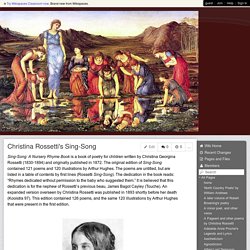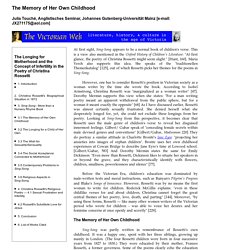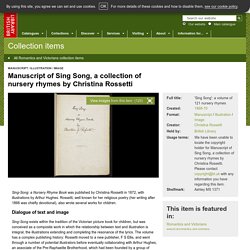

30 3. Victorian Poetry, Poetics and Contexts - Christina Rossetti's Sing-Song. Sing-Song: A Nursery Rhyme Book is a book of poetry for children written by Christina Georgina Rossetti (1830-1894) and originally published in 1872.

The original edition of Sing-Song contained 121 poems and 120 illustrations by Arthur Hughes. The poems are untitled, but are listed in a table of contents by first lines (Rossetti Sing-Song). The dedication in the book reads: “Rhymes dedicated without permission to the baby who suggested them.” It is believed that this dedication is for the nephew of Rossetti’s previous beau, James Bagot Cayley (Touche). An expanded version overseen by Christina Rossetti was published in 1893 shortly before her death (Kooistra 97). Retrieved from WikimediaSing-Song was published over two years after it was completed, following complicated negotiations involving four separate publishers (Kooistra 92). Christina Rossetti's Sing-Song and Nineteenth-Century Children's Poetry on JSTOR. Contemporary Problems in <span class="book">Sing-Song</span> Onstructing a mock ideal world does not stop Rossetti from addressing some of the problems of her age, with a special emphasis on infant mortality.

In Victorian times death was an ever present reality. Births were often fatal for both mother and child. And the missing knowledge about the importance of hygiene saw children at a constant risk for their lives throughout their childhood. Thus it is not unusual to present this fact of life within a book of nursery rhymes : Your brother has a falcon, Your sister has a flower; But what is left for mannikin, Born within an hour? I'll nurse you on my knee, my knee, My own little son; I'll rock you, rock you, in my arms, My least little one. [426. This poem shows how a mother awaits her child's death. The poem "Why did baby die" [428] shows the grief immediately after the child's death. Rossetti also addresses other social problems, for example poverty. The third problem Rossetti addresses is orphanage. Religious Aspects in Sing-Song. The Longing for Motherhood and the Concept of Infertility in the Poetry of Christina Rossetti.
At first sight, Sing-Song appears to be a normal book of children's verse.

This is a view also mentioned in the Oxford History of Children's Literature: "At first glance, the poetry of Christina Rossetti might seem slight. " [Hunt, 160]. Maria Verch also supports this idea. She speaks of the "traditionellen Themenkatalog" [125], out of which Rossetti picks her themes for the poems in Sing-Song. However, one has to consider Rossetti's position in Victorian society as a woman writer by the time she wrote the book. Before the Victorian Era, children's education was dominated by male-written texts and moral instructions, such as Bunyan's Pilgrim's Progress and Blake's Songs of Innocence.
The Memory of Her Own Childhood Sing-Song was partly written in remembrance of Rossetti's own childhood. Seldom 'can't', Seldom 'don't, Never 'shan't, Never 'won't. [431] This poem shows how Victorian children (including the Rossettis) were taught rules for their behaviour. Manuscript of Sing Song, a collection of nursery rhymes by Christina Rossetti.
English Sing-Song: a Nursery Rhyme Book was published by Christina Rossetti in 1872, with illustrations by Arthur Hughes.

Rossetti, well known for her religious poetry (her writing after 1866 was chiefly devotional), also wrote several works for children. Dialogue of text and image Sing-Song exists within the tradition of the Victorian picture book for children, but was conceived as a composite work in which the relationship between text and illustration is integral, the illustrations extending and completing the resonance of the lyrics.
The volume has a complex publishing history: Rossetti moved to a new publisher, F S Ellis, and went through a number of potential illustrators before eventually collaborating with Arthur Hughes, an associate of the Pre-Raphaelite Brotherhood, which had been founded by a group of painters including her brother, Dante Gabriel Rossetti. What does the manuscript reveal?